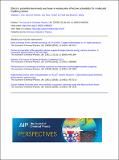Electric potential invariants and ions-in-molecules effective potentials for molecular Rydberg states
Author(s)
Zhou, Yan; Wong, Bryan M.; Coy, Stephen; Grimes, David Darrah; Field, Robert W
DownloadJCP_145_p234301.pdf (4.478Mb)
PUBLISHER_POLICY
Publisher Policy
Article is made available in accordance with the publisher's policy and may be subject to US copyright law. Please refer to the publisher's site for terms of use.
Terms of use
Metadata
Show full item recordAbstract
The dependence of multipole moments and polarizabilities on external fields appears in many applications including biomolecular molecular mechanics, optical non-linearity, nanomaterial calculations, and the perturbation of spectroscopic signatures in atomic clocks. Over a wide range of distances, distributed multipole and polarizability potentials can be applied to obtain the variation of atom-centered atoms-in-molecules electric properties like bonding-quenched polarizability. For cylindrically symmetric charge distributions, we examine single-center and atom-centered effective polarization potentials in a non-relativistic approximation for Rydberg states. For ions, the multipole expansion is strongly origin-dependent, but we note that origin-independent invariants can be defined. The several families of invariants correspond to optimized representations differing by origin and number of terms. Among them, a representation at the center of dipole polarizability optimizes the accuracy of the potential with terms through 1/r[superscript 4]. We formulate the single-center expansion in terms of polarization-modified effective multipole moments, defining a form related to the source-multipole expansion of Brink and Satchler. Atom-centered potentials are an origin independent alternative but are limited both by the properties allowed at each center and by the neglected effects like bond polarizability and charge flow. To enable comparisons between single-center effective potentials in Cartesian or spherical form and two-center effective potentials with differing levels of mutual induction between atomic centers, we give analytical expressions for the bond-length and origin-dependence of multipole and polarizability terms projected in the multipole and polarizability expansion of Buckingham. The atom-centered potentials can then be used with experimental data and ab initio calculations to estimate atoms-in-molecules properties. Some results are given for BaF[superscript +] and HF showing the utility and limitations of the approach. More detailed results on X[superscript 1]Σ[superscript +]CaF[superscript +] are published separately.
Date issued
2016-12Department
Massachusetts Institute of Technology. Department of ChemistryJournal
Journal of Chemical Physics
Publisher
American Institute of Physics (AIP)
Citation
Coy, Stephen L. et al. “Electric Potential Invariants and Ions-in-Molecules Effective Potentials for Molecular Rydberg States.” The Journal of Chemical Physics 145, 23 (December 2016): 234301
Version: Final published version
ISSN
0021-9606
1089-7690